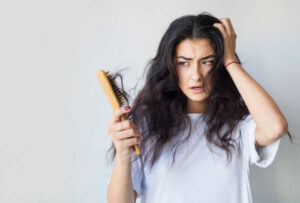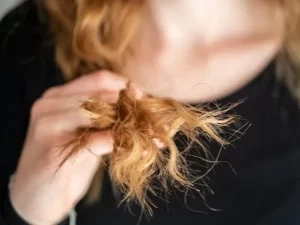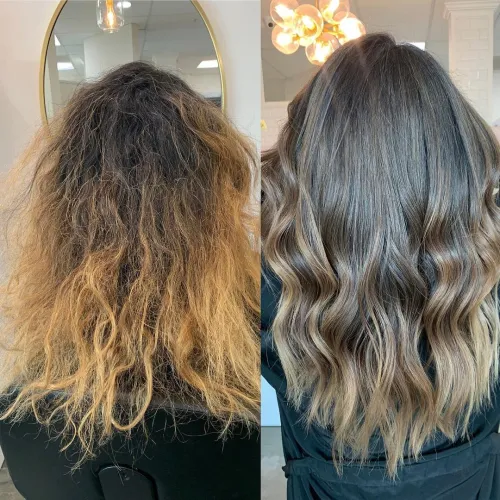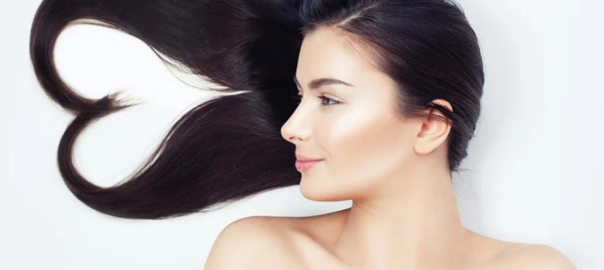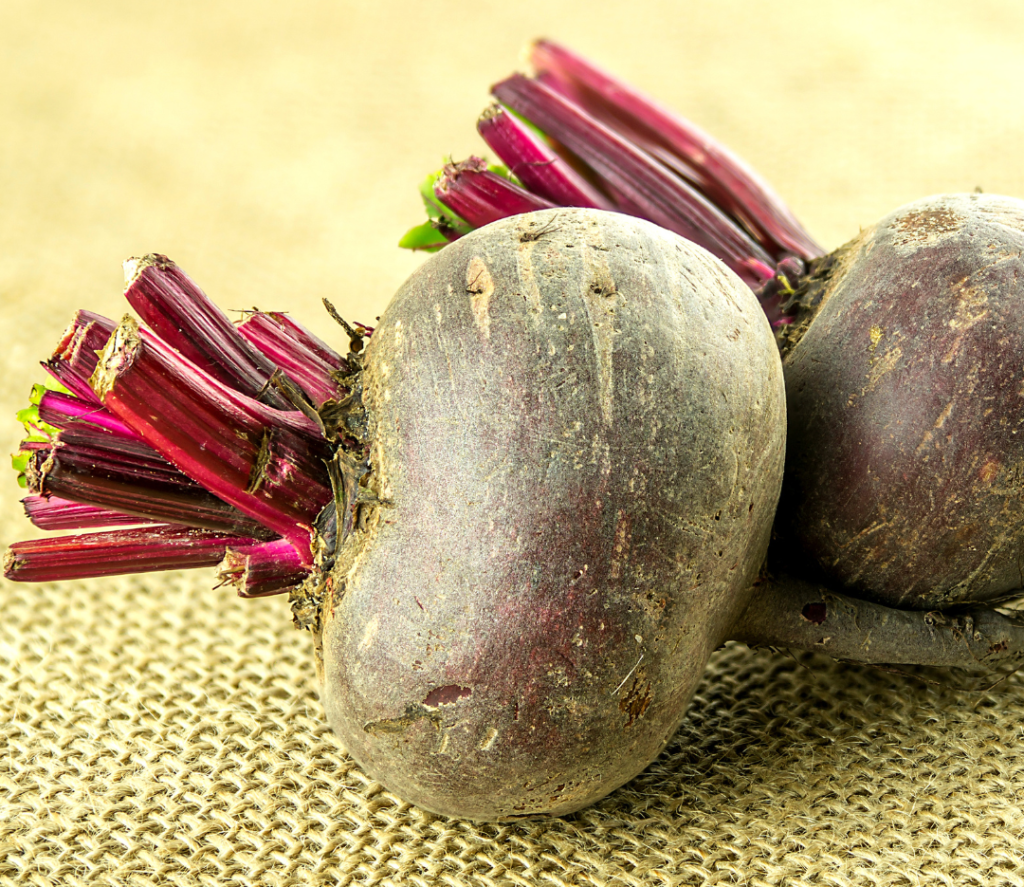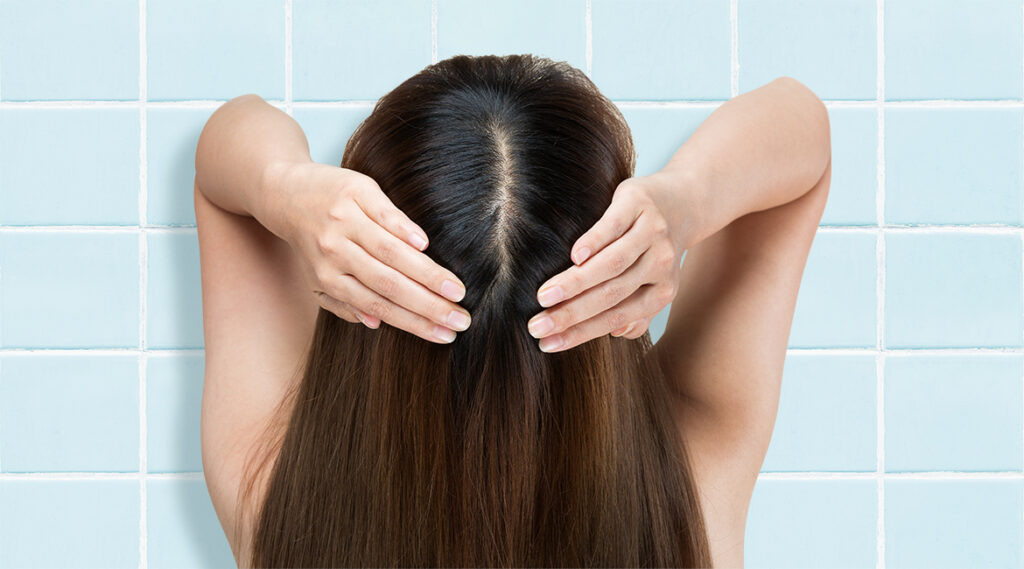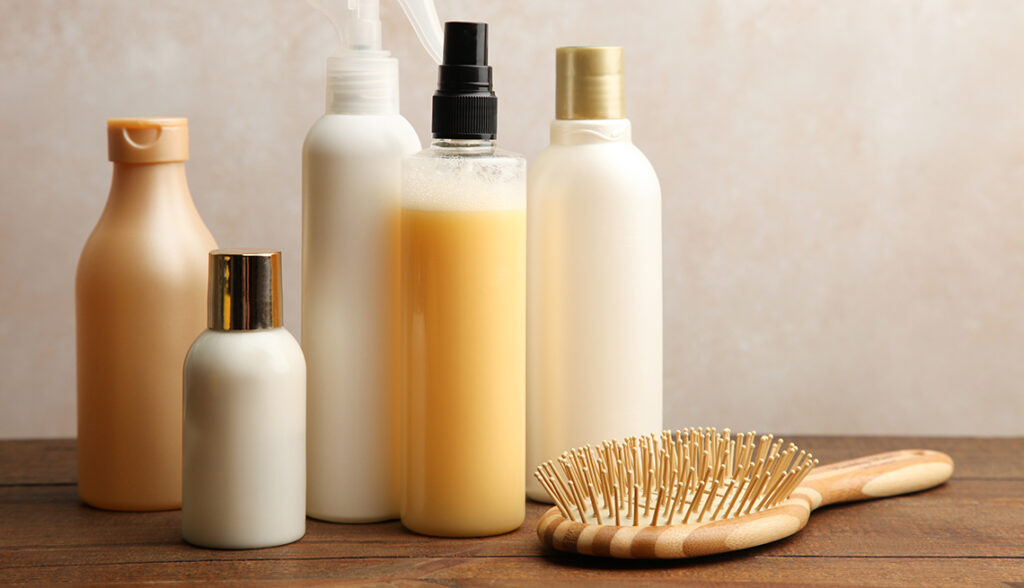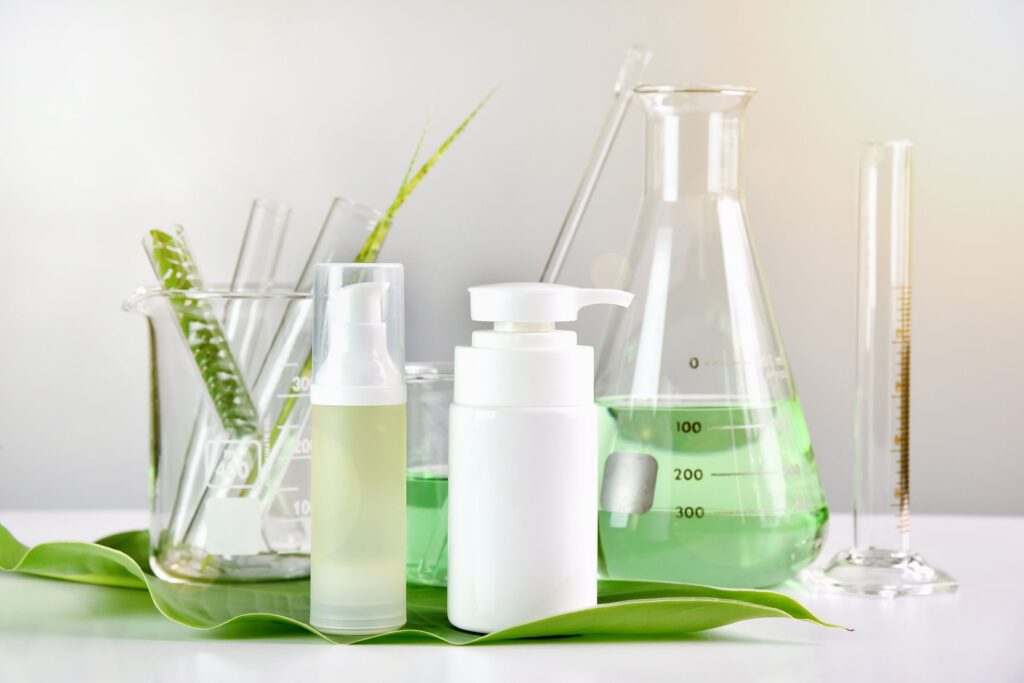Your hair is your canvas, and transformative treatments like hair bond repair and hair straightening offer unique ways to express your style and enhance your natural beauty. Whether you’re seeking to mend the effects of damage and embrace healthier locks or craving the sleek, polished look of straightened hair, you’ve come to the right place. Our blog will be your trusted companion on this hair transformation journey, providing you with natural insights, expert tips, and everything you need to know about these game-changing procedures. Say goodbye to bad hair days and hello to confidence and elegance – let’s dive in!
What is Hair Bond Repair?
Hair bond repair is a treatment designed to restore and strengthen the bonds within the hair shaft that may have been weakened or damaged due to various factors such as chemical treatments (e.g., coloring, perming), excessive heat styling, or environmental stressors. The treatment typically involves the use of specialized products that contain ingredients to rebuild and reinforce these bonds, like Tera Bond resulting in improved hair strength, elasticity, and overall health. It helps to reduce breakage, enhance manageability, and restore the hair’s natural shine and texture.
It’s important to note that hair bond repair treatment should be performed by trained professionals to ensure safety and desired results. Additionally, the treatment depends on individual preferences, hair type, and the specific goals you have for your hair.
Understanding Hair Bonds:
Hair, a marvel of nature, comprises a complex structure of proteins, primarily keratin, and a network of chemical bonds. Understanding these bonds is crucial to comprehend how our hair behaves, reacts to treatments, and why it sometimes needs a little extra care.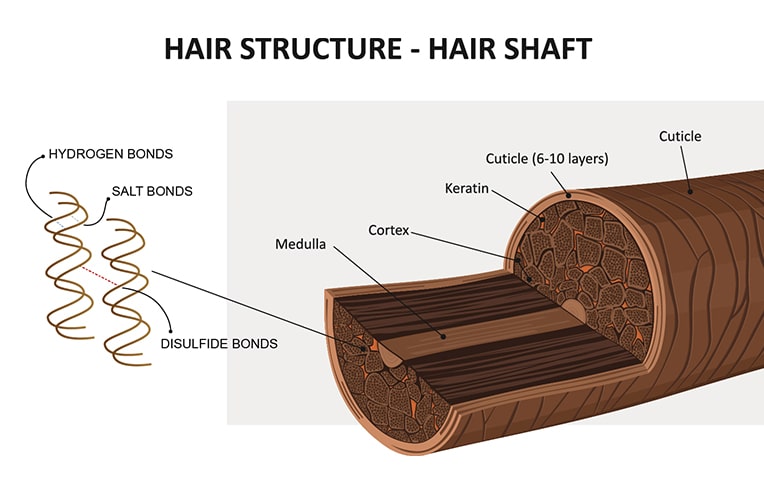
- Disulfide Bonds:
Nature: Strongest type of bonds in the hair.
Formation: Formed between sulfur atoms in two separate protein chains.
Function: Responsible for the hair’s overall strength and elasticity.
Impact: Chemical treatments and heat styling can break these bonds, leading to weakened hair.
- Hydrogen Bonds:
Nature: Weaker than disulfide bonds but crucial for hair structure.
Formation: Formed between the hydrogen atoms in one amino acid and the oxygen atoms in another.
Function: Contribute to hair flexibility and shape.
Impact: Temporary changes like those from heat or water; hair returns to its natural state when cooled or dried.
- Salt Bonds:
Nature: Weak bonds compared to disulfide and hydrogen bonds.
Formation: Attraction between positive and negative charges in amino acids.
Function: Help in maintaining the hair’s structure and stability.
Impact: This can be affected by pH changes in hair care products.
Understanding these bonds is fundamental as various hair treatments, including bond repair and straightening, work on manipulating these bonds to achieve specific results. Bond repair treatments aim to strengthen and restore these bonds, while hair straightening treatments involve altering them to achieve a smoother, straightened appearance.
Common Causes of Hair Damage:
Our hair is a testament to our identity and style, but it often faces a range of challenges that can leave it damaged and lackluster. Identifying the common culprits behind hair damage is the first step towards nurturing and revitalizing your locks.
-
Excessive Heat Styling:
Blow dryers, straighteners, and curling irons can expose your hair to high temperatures, leading to weakened and brittle strands. The heat strips away natural moisture, leaving hair dehydrated and prone to breakage.
-
Chemical Treatments:
Chemical processes like coloring, perming, and relaxing alter the hair’s structure, making it more susceptible to damage. These treatments often involve harsh chemicals that weaken the hair and, if not done correctly, can cause irreparable harm.
-
Overwashing and Harsh Shampoos:
Washing your hair too frequently or using shampoos with harsh ingredients can strip away the natural oils that protect and nourish the hair. This can result in a dry scalp, brittle hair, and increased breakage.
-
Tight Hairstyles and Hair Accessories:
Constantly tying your hair tightly or using hair accessories that pull can cause stress and damage to the hair shaft and follicles, leading to traction alopecia and thinning of the hair.
-
Environmental Factors:
Exposure to harsh weather conditions, pollution, UV rays, and saltwater can weaken the hair, making it more susceptible to damage and breakage.
-
Poor Diet and Nutrition:
A diet lacking in essential nutrients, especially protein, vitamins, and minerals, can result in weak, dull hair that is more prone to damage.
-
Lack of Moisture:
Insufficient hydration and moisturization can cause dryness and frizz, making the hair more susceptible to breakage and damage.
-
Physical and Mechanical Damage:
Vigorous towel-drying, rough brushing, or using inappropriate hair tools can cause physical damage to the hair cuticle, leading to breakage and split ends.
Signs of Damaged Hair
Your hair has a unique language, and understanding the signs of damage it’s expressing can be pivotal in preserving its health and beauty. Here are the key indicators that your hair might be in need of some tender loving care:
Appearance: Hair strands split into two or more ends at the tips.
Cause: Weakened, damaged hair shafts.
Solution: Regular trims and deep conditioning to prevent further splitting.
-
Dry and Brittle Texture:
Appearance: Hair lacks moisture, feels rough, and breaks easily.
Cause: Loss of natural oils or exposure to harsh chemicals and heat.
Solution: Deep conditioning treatments, avoiding excessive heat, and maintaining a balanced diet.
-
Excessive Frizz:
Appearance: Unmanageable, flyaway hair that lacks smoothness and shine.
Cause: Lack of moisture, damaged cuticles, or high humidity.
Solution: Hydrating masks, anti-frizz serums, and gentle drying techniques.
-
Lackluster and Dull Hair:
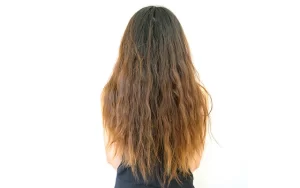 Appearance: Hair loses its shine and appears lifeless.
Appearance: Hair loses its shine and appears lifeless.
Cause: Product buildup, pollutants, or damaged cuticles.
Solution: Clarifying shampoos, regular cleansing, and protective hairstyles.
-
Tangled Hair:
Appearance: Hair frequently forms knots and tangles.
Cause: Damaged, rough hair cuticles.
Solution: Conditioning treatments, wide-toothed combs, and gentle detangling.
-
Easily Breakable Strands:
Appearance: Hair breaks or snaps easily, even with minimal force.
Cause: Weakened hair structure from excessive styling or chemical treatments.
Solution: Protein-rich treatments, avoiding over-styling, and protective hairstyles.
-
Scalp Issues:
Appearance: Dryness, itchiness, or flakiness of the scalp.
Cause: Improper hygiene, harsh products, or skin conditions.
Solution: Scalp treatments, gentle shampoos, and regular cleansing.
-
Changes in Elasticity:
 Appearance: Hair loses its stretch and doesn’t return to its original shape.
Appearance: Hair loses its stretch and doesn’t return to its original shape.
Cause: Protein loss from damage to the hair’s structure.
Solution: Protein treatments and minimizing damage through gentle care.
Understanding these signs is vital in tailoring your hair care routine and seeking appropriate treatments to restore your hair’s health.
Damaged Hair Repair with Tera Bond:
Hair bond repair treatments have emerged as a game-changer in the world of hair care, offering a pathway to mend and fortify the bonds within our hair. If you’ve been dealing with damaged, weakened, or over-processed hair, a bond repair treatment might be just what your locks need to regain their strength and vitality. This is where Tera Bond comes in. It is a reactive bond multiplier that repairs hair from the inside out. Its innovative formula is designed to deeply penetrate the hair, restoring and strengthening the weakened bonds.
1. It repairs broken bonds between proteins:
TeraBond works to restore hair shape, structure, and strength by repairing and reestablishing the broken bonds between proteins in the hair. This helps to improve the overall integrity and resilience of the hair.
-
Fills voids:
TeraBond fills in gaps or voids within the hair structure, reducing porosity. By doing so, it increases the hydrophobicity (repelling water) of the hair and enhances its resistance to humidity, contributing to better moisture retention and protection against environmental factors.
-
Smoothens the cuticle:
TeraBond smooths the hair cuticle, improving shine and enhancing the compatibility of the hair. A smooth cuticle reduces friction between hair strands and reinforces the hair fiber’s protective shield, promoting a healthier and shinier appearance.
-
Controls oxidation:
TeraBond helps control and slow down the rate of oxidation during chemical treatments. This is crucial in minimizing damage to the hair that can occur due to oxidative processes, which are often involved in various chemical treatments such as coloring or perming.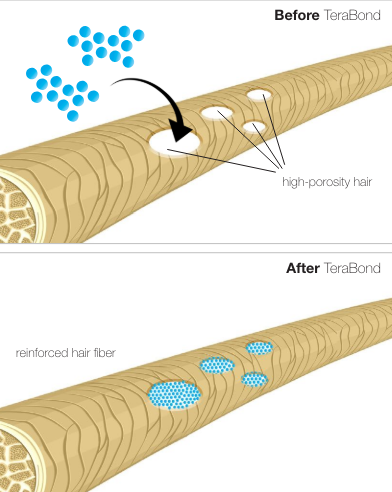
Some tried and tested treatments using Tera Bond on some common chemically treated hair are as follows:
-
Bleached Hair
To delve into the effects of various treatments on the hair’s health during bleaching, we conducted an extensive experiment using virgin black hair tresses. Our aim was to uncover the potential of treatments in reducing damage and promoting hair repair.
Materials Utilized:
TeraBond: An 8.5% solution in water, known for its potential protective qualities.
Olaplex #1: Utilized in accordance with the instructions specified on the packaging.
Bleach + Developer: The standard components of a typical bleaching mixture.
Experimental Procedure:
We meticulously designed a procedure to bleach the virgin black hair tresses, simulating a realistic bleaching scenario, to observe the impact of various treatments:
Untreated Tresses (Control Group): This group served as the baseline, allowing us to evaluate the natural effects of bleaching without any specific treatment.
TeraBond-Treated Tresses: For this group, we prepared a paste by combining the 8.5% TeraBond solution in water with bleach + developer. The resultant paste was gently applied to the tresses. Subsequently, the treated tresses underwent the bleaching process outlined in our procedure. After this, the tresses were thoroughly rinsed and left to air-dry.
Olaplex-Treated Tresses: Olaplex #1 was carefully applied, following the instructions provided on the packaging. The tresses were then subjected to the same bleaching process as in the previous groups. After the bleaching process, the tresses were rinsed and air-dried.
Results and Observations:
The results were illuminating, showcasing the varying effects of each treatment on the bleached hair tresses:
Untreated Tresses: As anticipated, the untreated tresses exhibited extensive damage following the rigorous bleaching process.
Olaplex-Treated Tresses: Tresses treated with Olaplex displayed visible signs of repair, suggesting the potential of Olaplex to mitigate damage and improve the overall health of the hair post-bleaching.
TeraBond-Treated Tresses: The most promising results were observed with the tresses treated with TeraBond. They displayed a substantial reduction in damage and showcased even more pronounced signs of repair compared to the Olaplex-treated tresses. TeraBond seemed to be highly effective in minimizing the damage typically associated with bleaching, highlighting its potential as a protective and reparative treatment. 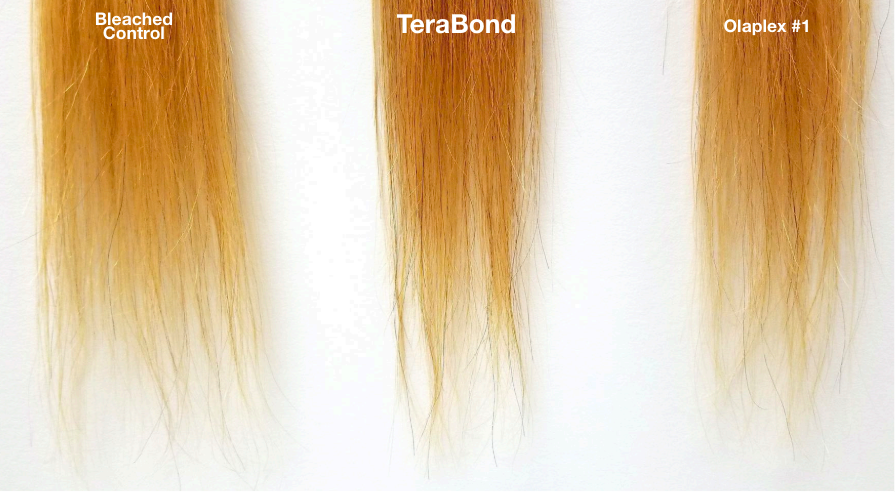
This experiment shed light on the significance of using appropriate treatments during the bleaching process. While Olaplex showcased its repair capabilities, TeraBond emerged as a standout, demonstrating its potential to not only repair but also provide a protective shield for the hair, paving the way for healthier and happier tresses in the realm of hair coloring and styling.
-
Color Treatment
Similar observations were noted for hair with color treatment. In Untreated Tresses the shine of untreated tresses is dull and diffused, lacking a distinct shine or gloss. The individual hair fibers are thin, resulting in lower overall volume, giving a thin and flat appearance to the tresses.
In Bond Multiplier Tresses (Treated with TeraBond and Olaplex), have distinct and bright white shine bands, indicating enhanced shine and gloss. It also results in thicker individual hair fibers and increased tress volume, giving a fuller and more voluminous appearance to the tresses.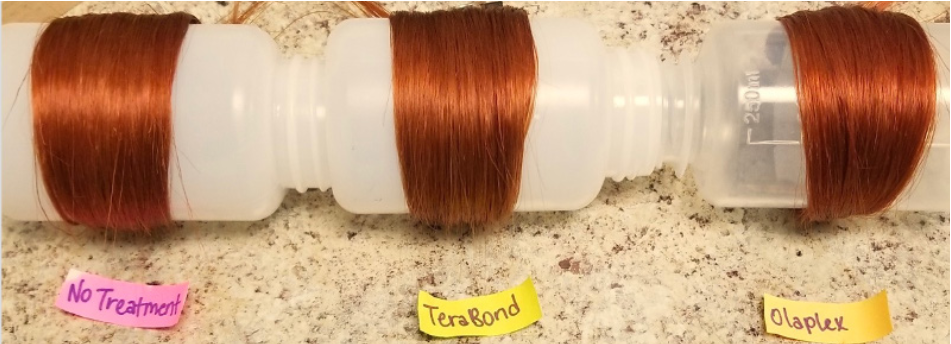
Tera Bond by United Descaler offers an effective solution to revive and fortify your hair’s bonds, providing a pathway to healthier, more resilient locks.
Maintaining Repaired Hair Locks:
Maintaining that sleek look and ensuring the health of your hair requires some care and attention. Here are essential tips to keep your hair looking fabulous and healthy:
-
Protective Hairstyles:
Choose protective styles like buns, braids, or ponytails to minimize daily manipulation and friction that can cause frizz or damage to your repaired hair.
-
Silk or Satin Pillowcases:
Sleep on a silk or satin pillowcase to reduce friction and prevent your hair from getting tangled or frizzy while you sleep.
-
Use Heat Protectants:
Before using any heat styling tools, apply a good quality heat protectant to shield your hair from the damaging effects of heat.
-
Regular Trims:
Schedule regular trims to keep split ends at bay and maintain the healthy look. Aim for a trim every 6-8 weeks.
-
Avoid Over-Washing:
Reduce the frequency of washing your hair to prevent excess dryness. When you do wash, use a sulfate-free shampoo and a moisturizing conditioner.
-
Cold Water Rinses:
Rinse your hair with cold water after conditioning to seal the cuticles, promoting a smoother and shinier appearance.
-
Deep Conditioning:
Incorporate deep conditioning treatments into your routine to nourish and moisturize your hair.
-
Limit Exposure to Humidity:
Use anti-humidity products to maintain your hairstyle during humid weather.
-
Regular Oil Treatments:
– Apply a light, nourishing oil such as argan or jojoba oil to the ends of your hair to keep it hydrated and prevent split ends.
-
Professional Maintenance:
– Schedule touch-up appointments with your stylist for any necessary treatments to keep your hair looking fresh and well-maintained.
-
Balanced Diet and Hydration:
– Eat a balanced diet rich in vitamins, minerals, and proteins, and stay well-hydrated for overall hair health.
By following these tips and maintaining a consistent hair care routine, you can prolong the sleek and healthy appearance of your hair while ensuring its long-term health and vitality. Enjoy your beautiful tresses!
Preventing Future Damage:
Preventing future hair damage is crucial for maintaining healthy and beautiful hair in the long term. Here are some effective strategies:
- Limit Heat Styling: Minimize the use of heated styling tools and always apply a heat protectant when you use them.
- Air Dry Whenever Possible: Allow your hair to air dry naturally to reduce exposure to heat and maintain its moisture levels.
- Protect Your Hair from the Sun: Wear a hat or use hair products with SPF to protect your hair from the sun’s harmful UV rays.
- Regular Conditioning: Condition your hair after each wash to replenish moisture and improve its elasticity. Use deep conditioning treatments weekly for an extra boost of hydration.
- Gentle Towel-Drying: Gently squeeze excess water from your hair using a soft, microfiber towel to avoid breakage.
- Wide-Toothed Comb: Use a wide-toothed comb to detangle wet hair gently, starting from the ends and working your way up.
- Low-Manipulation Hairstyles: Opt for hairstyles that require minimal pulling, twisting, or braiding to reduce stress on the hair shaft and scalp.
- Regular Scalp Massage: Massage your scalp regularly to promote blood circulation and a healthy scalp environment, encouraging hair growth and strength.
- Balanced Diet: Maintain a diet rich in vitamins, minerals, and proteins essential for healthy hair growth by incorporating fruits, vegetables, lean proteins, and whole grains into your meals.
- Hydration: Drink plenty of water daily to keep your body and hair well-hydrated, which is key to maintaining healthy hair.
- Avoid Excessive Chemical Treatments: Minimize chemical treatments like perming, coloring, and bleaching to reduce damage to the hair’s structure.
- Regular Check-ups: Visit a professional stylist regularly for trims and assessments of your hair’s health and condition.
- Listen to Your Hair: Pay attention to how your hair responds to various treatments and adjust your routine accordingly. Every individual’s hair is unique and may require different care.
By following these tips and adopting a gentle, holistic approach to hair care, you can protect your hair from potential damage and promote a lifetime of healthy, beautiful locks. Your hair deserves the best care, so treat it with love and attention!
Hair Bond Repair Myths:
In the realm of hair care and styling, myths and misconceptions often circulate about bond repair and chemical treatments. Let’s set the record straight by debunking some common myths associated with these transformative procedures:
Myth 1: “Bond Repair and Straightening Are the Same Thing”
Reality: Bond repair and hair straightening are distinct treatments with different purposes. Bond repair aims to strengthen and rebuild the hair’s internal structure, while hair straightening focuses on altering the hair’s natural texture to achieve a straightened appearance.
Myth 2: “Hair Bond Repair is Only for Severely Damaged Hair”
Reality: Hair bond repair treatments are beneficial for a wide range of hair conditions, not just severely damaged hair. Even if your hair isn’t severely damaged, these treatments can provide immense benefits in strengthening and maintaining healthy hair.
Myth 3: “Hair Bond Repair Treatments are Painful or Uncomfortable”
Reality: Hair bond repair treatments are typically painless and comfortable. The application involves the use of specially formulated products that are gentle on the hair and scalp. If you experience any discomfort, it’s essential to communicate with your stylist immediately.
Understanding the truth behind these myths is essential for making informed decisions about hair treatments. Always consult a professional stylist and conduct thorough research before undergoing any hair treatment. Your hair’s health and well-being should be a top priority.
FAQs:
Here are answers to some common questions about hair bond repair, hair straightening, and related topics:
- What is hair bond repair, and how does it work?
Hair bond repair is a process that helps restore and strengthen the bonds within the hair shaft, which can be broken or damaged due to various factors like heat styling, chemical treatments, or environmental exposure. It typically involves using specialized products that penetrate the hair shaft and repair these bonds, improving the hair’s strength and vitality.
- Is hair bond repair suitable for all hair types?
Yes, hair bond repair is generally suitable for all hair types, including damaged, colored, chemically treated, or naturally healthy hair. It helps improve the overall health and strength of the hair.
- How often should I get a hair bond repair treatment?
The frequency of hair bond repair treatments can vary based on your hair’s condition and the specific product or treatment being used. Typically, it’s recommended to have a hair bond repair treatment every 4 to 6 weeks, or as advised by your stylist.
- Are there natural alternatives to chemical hair treatments?
Yes, there are natural alternatives like using straightening brushes, blow-drying techniques, or natural ingredients such as aloe vera, coconut milk, or honey. These alternatives may help achieve a temporary straightened look without using harsh chemicals.
Always consult a professional stylist for personalized advice regarding hair treatments and care. Your hair’s health and safety should be a top priority in any hair care routine.


